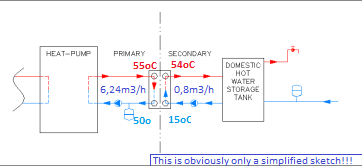Hello.
We say that heat pumps function with a ΔΤ of 5°.
Let's say we want to heat fresh water entering our storage tank at 15°C (as it comes from the water main) to 54°C at a flow rate of 0,8m³/h (our secondary circuit).
The primary circuit should have a ΔΤ of 5°. Roughly, by energy balance we obtain primary flow equal to 6,24m³/h.

We size accordingly the plate heat exchanger and both of circulators and then we install them and things work as expected.
Now, it happens sometimes that fresh water may enter our tank at a higher temperature, e.g. 25°C or maybe even 30°C (due e.g. to a hotter month or due to a preheat from some heat recovery or combination of both etc.). The desired temperature of our DHW is still 54°C so secondary ΔΤ is lower than before. Considering also the same secondary flow rate, the heat power needed now is less than before.
So for the same initial heat exchanger and considering the primary same flow rate with primary hot temperature still of 55°C the return temperature will be not 50°C(ΔΤ of 5°C) but higher (since less heat power is demanded by secondary) so primary ΔΤ is messed up.
1)We use to say then that heat pump will cut off too quickly, turn on and off frequently etc.
If it is so how will it ever be possible to heat a significant volume of water? Is there any risk that pretty much all of our tank water volume will stay at 25°C?
(In practice somehow it works)
2)Theoretically if we want to keep our primary conditions constant(temperatures and flow rate), when secondary ΔΤ drops we could raise accordingly the secondary flow rate-through a variable speed circulator- in order to absorb the same heat power(and not less) by having the secondary circulator always targetting the primary outlet temperature at 50°C.
Is it something that can work?
Is there any point in doing it?
We say that heat pumps function with a ΔΤ of 5°.
Let's say we want to heat fresh water entering our storage tank at 15°C (as it comes from the water main) to 54°C at a flow rate of 0,8m³/h (our secondary circuit).
The primary circuit should have a ΔΤ of 5°. Roughly, by energy balance we obtain primary flow equal to 6,24m³/h.

We size accordingly the plate heat exchanger and both of circulators and then we install them and things work as expected.
Now, it happens sometimes that fresh water may enter our tank at a higher temperature, e.g. 25°C or maybe even 30°C (due e.g. to a hotter month or due to a preheat from some heat recovery or combination of both etc.). The desired temperature of our DHW is still 54°C so secondary ΔΤ is lower than before. Considering also the same secondary flow rate, the heat power needed now is less than before.
So for the same initial heat exchanger and considering the primary same flow rate with primary hot temperature still of 55°C the return temperature will be not 50°C(ΔΤ of 5°C) but higher (since less heat power is demanded by secondary) so primary ΔΤ is messed up.
1)We use to say then that heat pump will cut off too quickly, turn on and off frequently etc.
If it is so how will it ever be possible to heat a significant volume of water? Is there any risk that pretty much all of our tank water volume will stay at 25°C?
(In practice somehow it works)
2)Theoretically if we want to keep our primary conditions constant(temperatures and flow rate), when secondary ΔΤ drops we could raise accordingly the secondary flow rate-through a variable speed circulator- in order to absorb the same heat power(and not less) by having the secondary circulator always targetting the primary outlet temperature at 50°C.
Is it something that can work?
Is there any point in doing it?

![[shadeshappy] [shadeshappy] [shadeshappy]](/data/assets/smilies/shadeshappy.gif)
